Finance and Funding Analysis for Travel and Tourism Sector Report
VerifiedAdded on 2020/10/22
|15
|3815
|320
Report
AI Summary
This report provides a detailed analysis of finance and funding within the travel and tourism sector. It begins with an introduction to the importance of finance and funding in the industry, followed by an examination of cost-volume-profit analysis, pricing methods, and factors influencing profitability. The report then delves into management accounting, including budgeting, financial statements, variance analysis, and management information systems, and their applications in decision-making. The analysis includes the use of ratio analysis and capital budgeting techniques. The report also explores sources and distribution of funding for capital projects, offering insights into the financial strategies and challenges within the travel and tourism sector. The report uses the example of Carnival Corporation & plc to illustrate the concepts discussed.
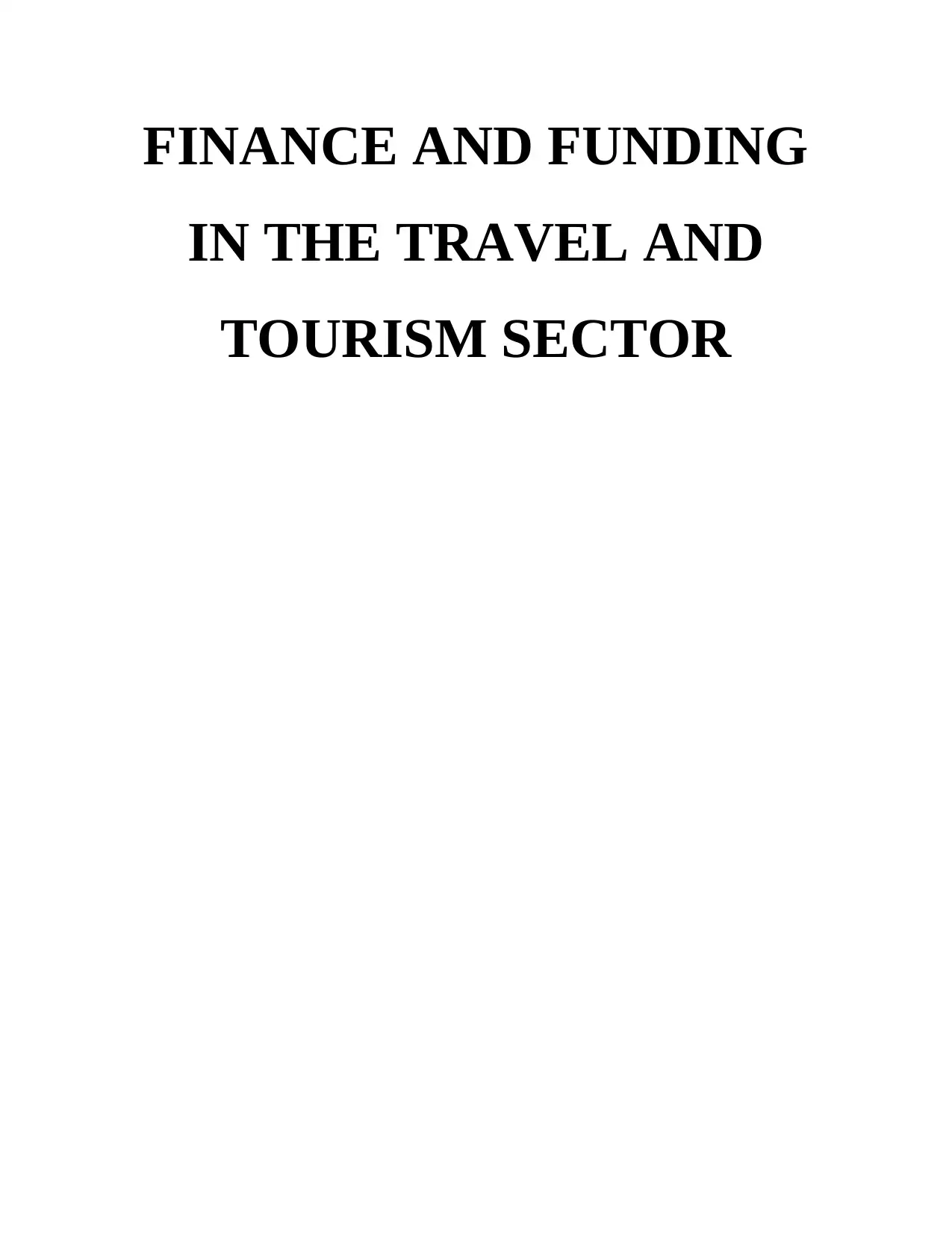
FINANCE AND FUNDING
IN THE TRAVEL AND
TOURISM SECTOR
IN THE TRAVEL AND
TOURISM SECTOR
Paraphrase This Document
Need a fresh take? Get an instant paraphrase of this document with our AI Paraphraser
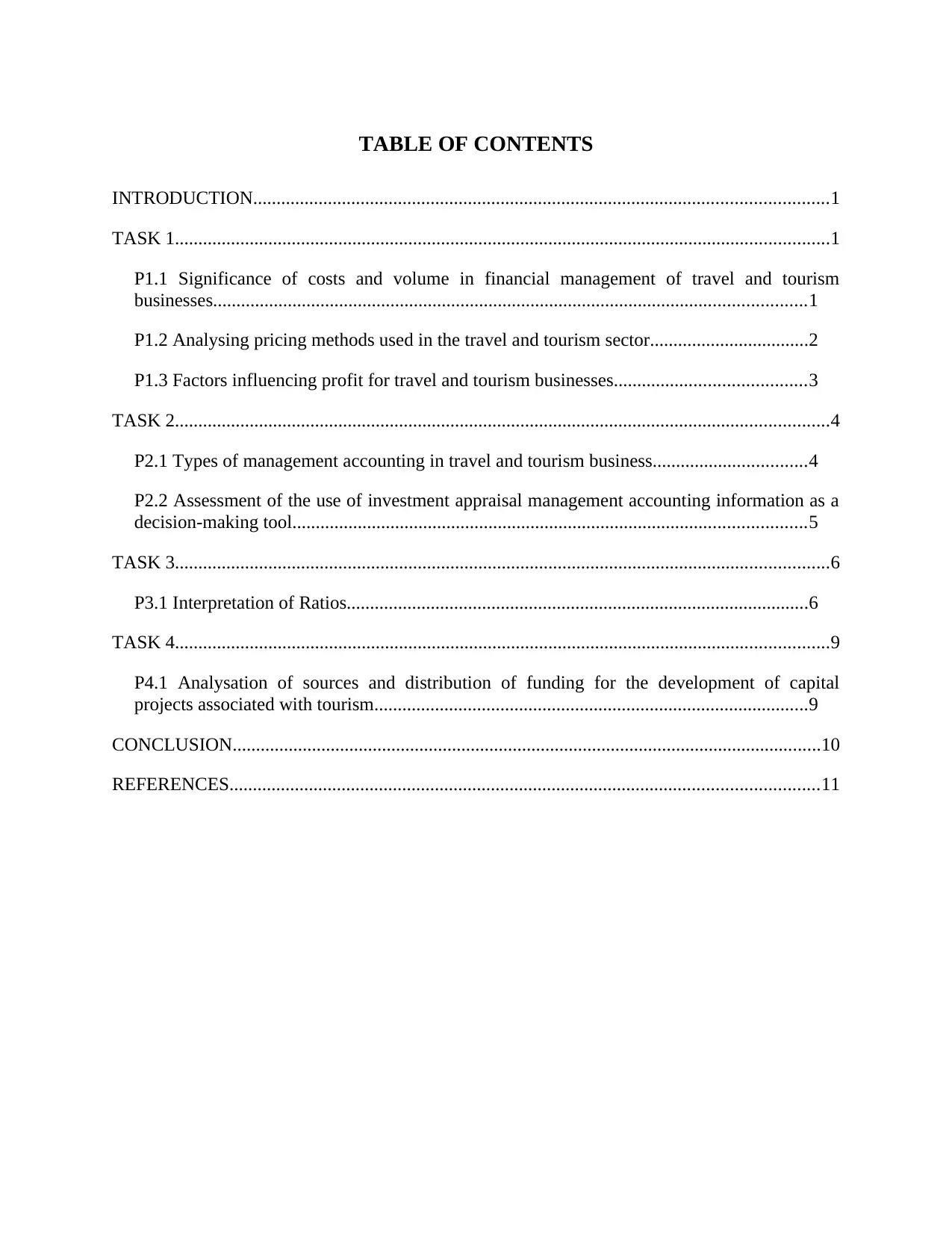
TABLE OF CONTENTS
INTRODUCTION...........................................................................................................................1
TASK 1............................................................................................................................................1
P1.1 Significance of costs and volume in financial management of travel and tourism
businesses...............................................................................................................................1
P1.2 Analysing pricing methods used in the travel and tourism sector..................................2
P1.3 Factors influencing profit for travel and tourism businesses.........................................3
TASK 2............................................................................................................................................4
P2.1 Types of management accounting in travel and tourism business.................................4
P2.2 Assessment of the use of investment appraisal management accounting information as a
decision-making tool..............................................................................................................5
TASK 3............................................................................................................................................6
P3.1 Interpretation of Ratios...................................................................................................6
TASK 4............................................................................................................................................9
P4.1 Analysation of sources and distribution of funding for the development of capital
projects associated with tourism.............................................................................................9
CONCLUSION..............................................................................................................................10
REFERENCES..............................................................................................................................11
INTRODUCTION...........................................................................................................................1
TASK 1............................................................................................................................................1
P1.1 Significance of costs and volume in financial management of travel and tourism
businesses...............................................................................................................................1
P1.2 Analysing pricing methods used in the travel and tourism sector..................................2
P1.3 Factors influencing profit for travel and tourism businesses.........................................3
TASK 2............................................................................................................................................4
P2.1 Types of management accounting in travel and tourism business.................................4
P2.2 Assessment of the use of investment appraisal management accounting information as a
decision-making tool..............................................................................................................5
TASK 3............................................................................................................................................6
P3.1 Interpretation of Ratios...................................................................................................6
TASK 4............................................................................................................................................9
P4.1 Analysation of sources and distribution of funding for the development of capital
projects associated with tourism.............................................................................................9
CONCLUSION..............................................................................................................................10
REFERENCES..............................................................................................................................11
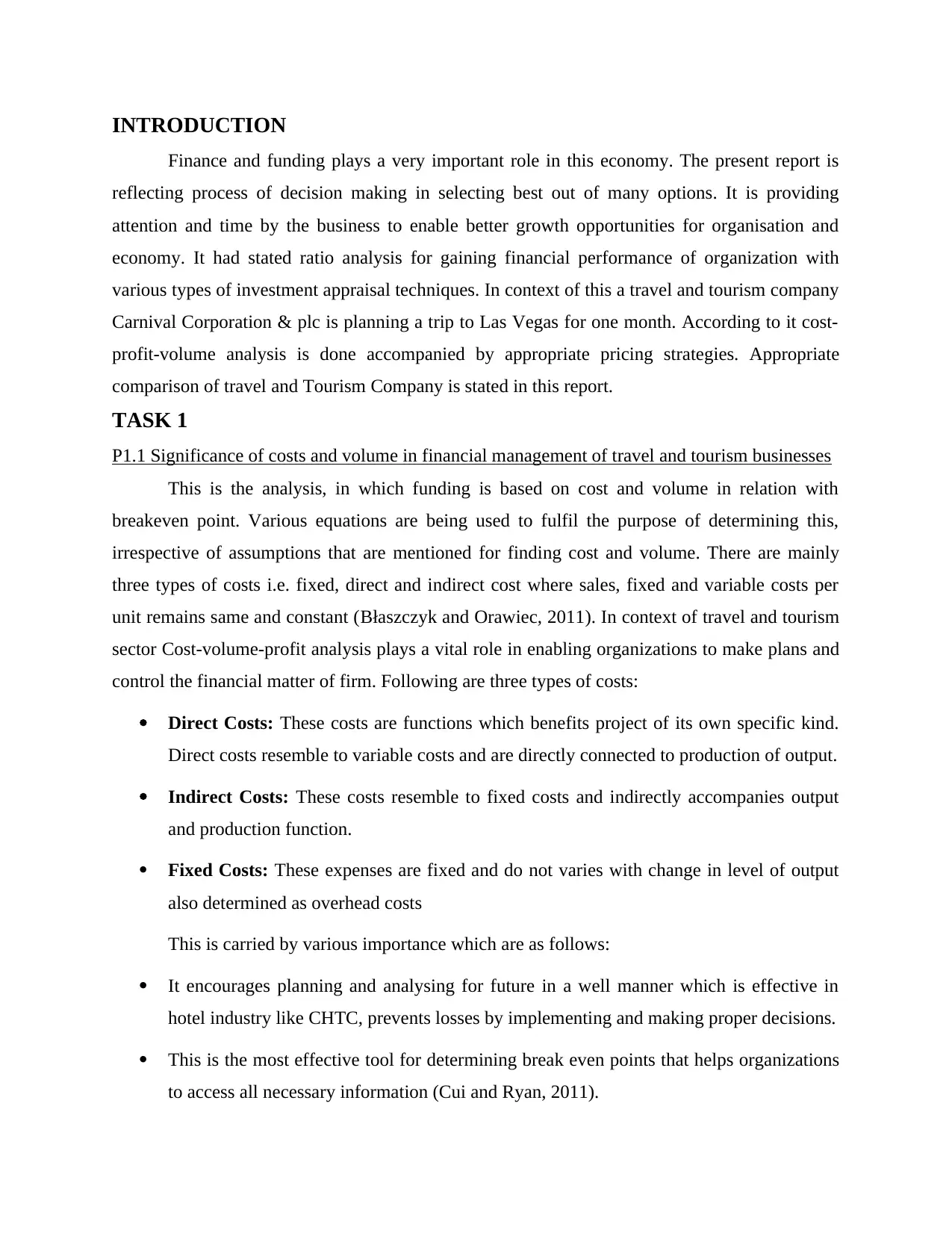
INTRODUCTION
Finance and funding plays a very important role in this economy. The present report is
reflecting process of decision making in selecting best out of many options. It is providing
attention and time by the business to enable better growth opportunities for organisation and
economy. It had stated ratio analysis for gaining financial performance of organization with
various types of investment appraisal techniques. In context of this a travel and tourism company
Carnival Corporation & plc is planning a trip to Las Vegas for one month. According to it cost-
profit-volume analysis is done accompanied by appropriate pricing strategies. Appropriate
comparison of travel and Tourism Company is stated in this report.
TASK 1
P1.1 Significance of costs and volume in financial management of travel and tourism businesses
This is the analysis, in which funding is based on cost and volume in relation with
breakeven point. Various equations are being used to fulfil the purpose of determining this,
irrespective of assumptions that are mentioned for finding cost and volume. There are mainly
three types of costs i.e. fixed, direct and indirect cost where sales, fixed and variable costs per
unit remains same and constant (Błaszczyk and Orawiec, 2011). In context of travel and tourism
sector Cost-volume-profit analysis plays a vital role in enabling organizations to make plans and
control the financial matter of firm. Following are three types of costs:
Direct Costs: These costs are functions which benefits project of its own specific kind.
Direct costs resemble to variable costs and are directly connected to production of output.
Indirect Costs: These costs resemble to fixed costs and indirectly accompanies output
and production function.
Fixed Costs: These expenses are fixed and do not varies with change in level of output
also determined as overhead costs
This is carried by various importance which are as follows:
It encourages planning and analysing for future in a well manner which is effective in
hotel industry like CHTC, prevents losses by implementing and making proper decisions.
This is the most effective tool for determining break even points that helps organizations
to access all necessary information (Cui and Ryan, 2011).
Finance and funding plays a very important role in this economy. The present report is
reflecting process of decision making in selecting best out of many options. It is providing
attention and time by the business to enable better growth opportunities for organisation and
economy. It had stated ratio analysis for gaining financial performance of organization with
various types of investment appraisal techniques. In context of this a travel and tourism company
Carnival Corporation & plc is planning a trip to Las Vegas for one month. According to it cost-
profit-volume analysis is done accompanied by appropriate pricing strategies. Appropriate
comparison of travel and Tourism Company is stated in this report.
TASK 1
P1.1 Significance of costs and volume in financial management of travel and tourism businesses
This is the analysis, in which funding is based on cost and volume in relation with
breakeven point. Various equations are being used to fulfil the purpose of determining this,
irrespective of assumptions that are mentioned for finding cost and volume. There are mainly
three types of costs i.e. fixed, direct and indirect cost where sales, fixed and variable costs per
unit remains same and constant (Błaszczyk and Orawiec, 2011). In context of travel and tourism
sector Cost-volume-profit analysis plays a vital role in enabling organizations to make plans and
control the financial matter of firm. Following are three types of costs:
Direct Costs: These costs are functions which benefits project of its own specific kind.
Direct costs resemble to variable costs and are directly connected to production of output.
Indirect Costs: These costs resemble to fixed costs and indirectly accompanies output
and production function.
Fixed Costs: These expenses are fixed and do not varies with change in level of output
also determined as overhead costs
This is carried by various importance which are as follows:
It encourages planning and analysing for future in a well manner which is effective in
hotel industry like CHTC, prevents losses by implementing and making proper decisions.
This is the most effective tool for determining break even points that helps organizations
to access all necessary information (Cui and Ryan, 2011).
⊘ This is a preview!⊘
Do you want full access?
Subscribe today to unlock all pages.

Trusted by 1+ million students worldwide
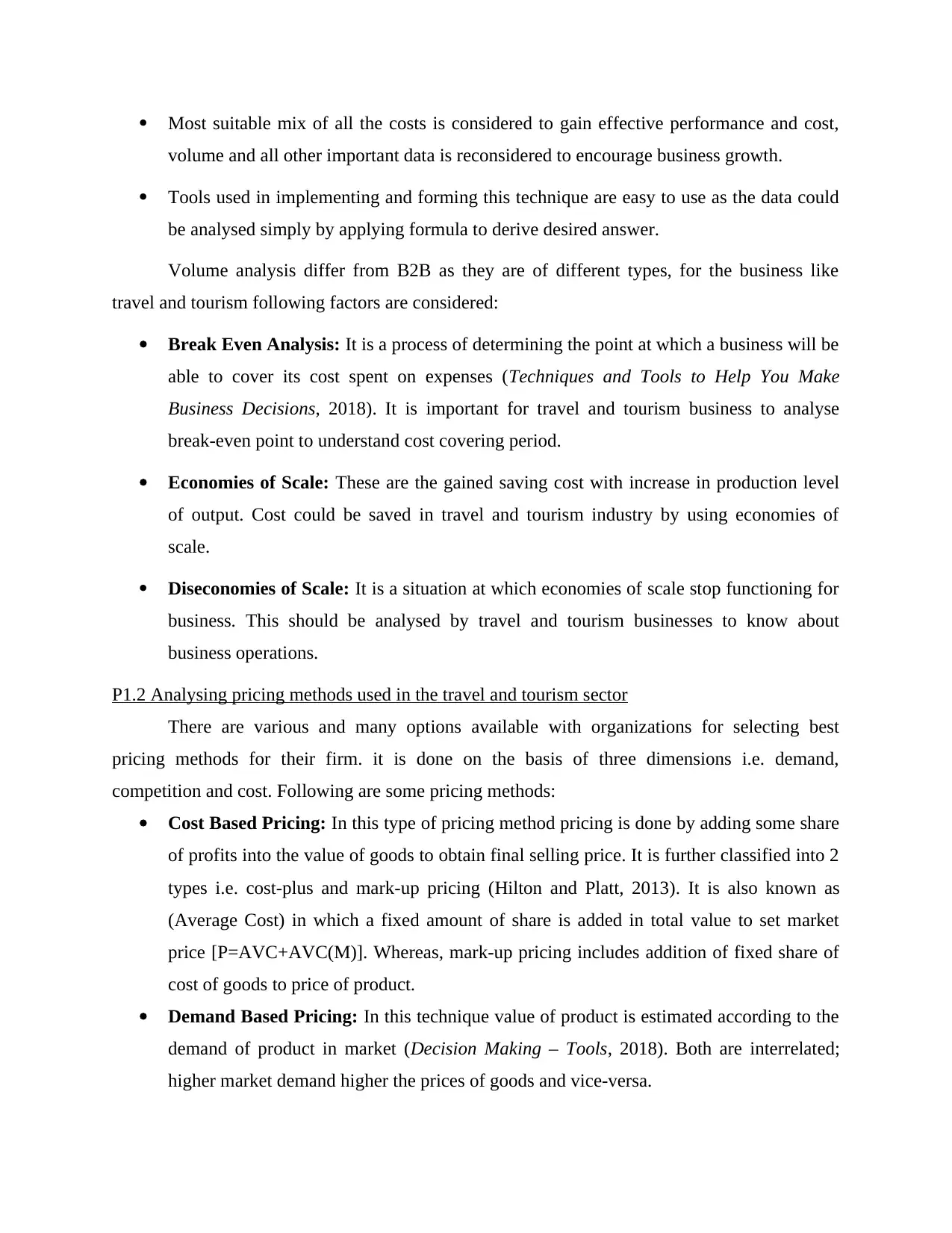
Most suitable mix of all the costs is considered to gain effective performance and cost,
volume and all other important data is reconsidered to encourage business growth.
Tools used in implementing and forming this technique are easy to use as the data could
be analysed simply by applying formula to derive desired answer.
Volume analysis differ from B2B as they are of different types, for the business like
travel and tourism following factors are considered:
Break Even Analysis: It is a process of determining the point at which a business will be
able to cover its cost spent on expenses (Techniques and Tools to Help You Make
Business Decisions, 2018). It is important for travel and tourism business to analyse
break-even point to understand cost covering period.
Economies of Scale: These are the gained saving cost with increase in production level
of output. Cost could be saved in travel and tourism industry by using economies of
scale.
Diseconomies of Scale: It is a situation at which economies of scale stop functioning for
business. This should be analysed by travel and tourism businesses to know about
business operations.
P1.2 Analysing pricing methods used in the travel and tourism sector
There are various and many options available with organizations for selecting best
pricing methods for their firm. it is done on the basis of three dimensions i.e. demand,
competition and cost. Following are some pricing methods:
Cost Based Pricing: In this type of pricing method pricing is done by adding some share
of profits into the value of goods to obtain final selling price. It is further classified into 2
types i.e. cost-plus and mark-up pricing (Hilton and Platt, 2013). It is also known as
(Average Cost) in which a fixed amount of share is added in total value to set market
price [P=AVC+AVC(M)]. Whereas, mark-up pricing includes addition of fixed share of
cost of goods to price of product.
Demand Based Pricing: In this technique value of product is estimated according to the
demand of product in market (Decision Making – Tools, 2018). Both are interrelated;
higher market demand higher the prices of goods and vice-versa.
volume and all other important data is reconsidered to encourage business growth.
Tools used in implementing and forming this technique are easy to use as the data could
be analysed simply by applying formula to derive desired answer.
Volume analysis differ from B2B as they are of different types, for the business like
travel and tourism following factors are considered:
Break Even Analysis: It is a process of determining the point at which a business will be
able to cover its cost spent on expenses (Techniques and Tools to Help You Make
Business Decisions, 2018). It is important for travel and tourism business to analyse
break-even point to understand cost covering period.
Economies of Scale: These are the gained saving cost with increase in production level
of output. Cost could be saved in travel and tourism industry by using economies of
scale.
Diseconomies of Scale: It is a situation at which economies of scale stop functioning for
business. This should be analysed by travel and tourism businesses to know about
business operations.
P1.2 Analysing pricing methods used in the travel and tourism sector
There are various and many options available with organizations for selecting best
pricing methods for their firm. it is done on the basis of three dimensions i.e. demand,
competition and cost. Following are some pricing methods:
Cost Based Pricing: In this type of pricing method pricing is done by adding some share
of profits into the value of goods to obtain final selling price. It is further classified into 2
types i.e. cost-plus and mark-up pricing (Hilton and Platt, 2013). It is also known as
(Average Cost) in which a fixed amount of share is added in total value to set market
price [P=AVC+AVC(M)]. Whereas, mark-up pricing includes addition of fixed share of
cost of goods to price of product.
Demand Based Pricing: In this technique value of product is estimated according to the
demand of product in market (Decision Making – Tools, 2018). Both are interrelated;
higher market demand higher the prices of goods and vice-versa.
Paraphrase This Document
Need a fresh take? Get an instant paraphrase of this document with our AI Paraphraser
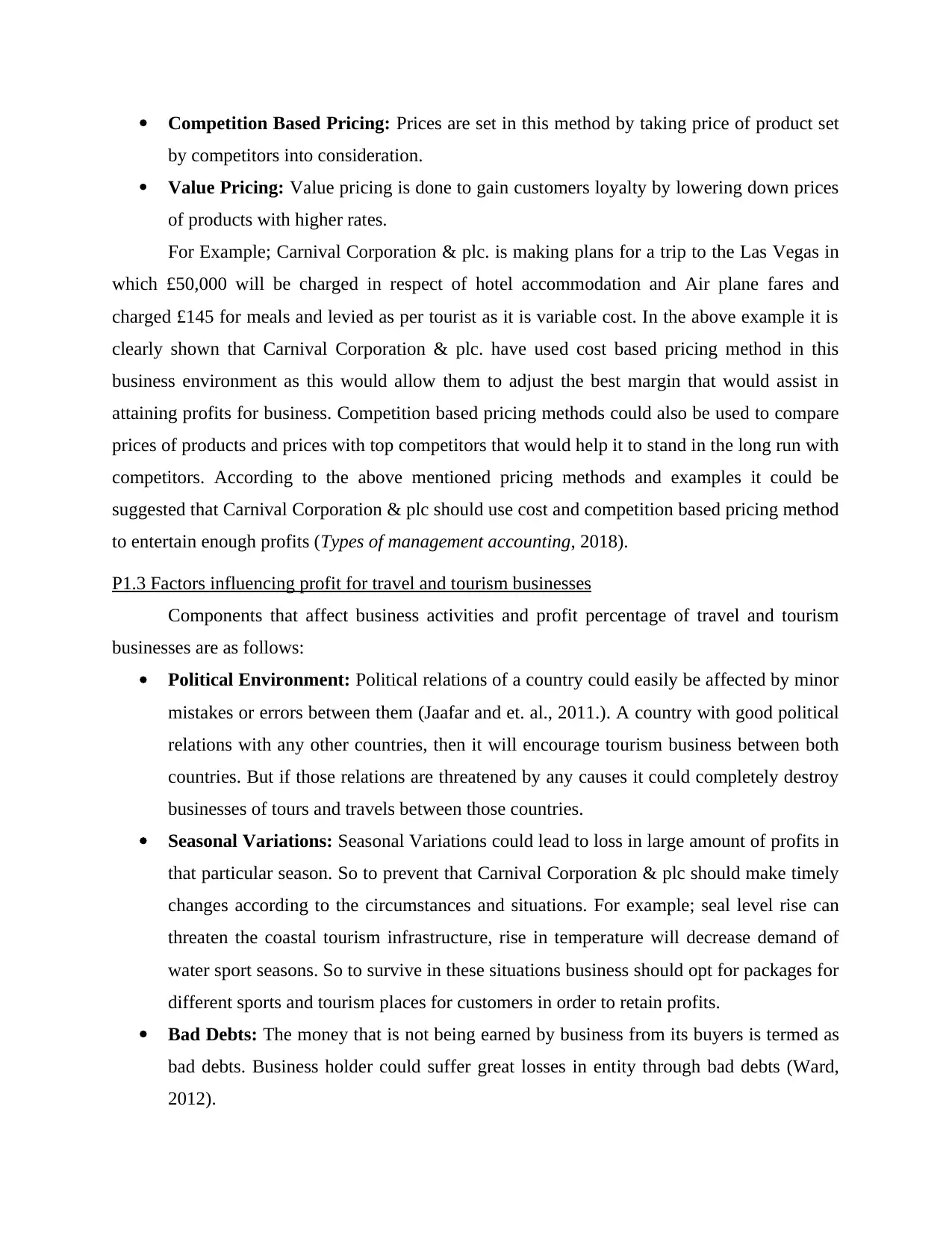
Competition Based Pricing: Prices are set in this method by taking price of product set
by competitors into consideration.
Value Pricing: Value pricing is done to gain customers loyalty by lowering down prices
of products with higher rates.
For Example; Carnival Corporation & plc. is making plans for a trip to the Las Vegas in
which £50,000 will be charged in respect of hotel accommodation and Air plane fares and
charged £145 for meals and levied as per tourist as it is variable cost. In the above example it is
clearly shown that Carnival Corporation & plc. have used cost based pricing method in this
business environment as this would allow them to adjust the best margin that would assist in
attaining profits for business. Competition based pricing methods could also be used to compare
prices of products and prices with top competitors that would help it to stand in the long run with
competitors. According to the above mentioned pricing methods and examples it could be
suggested that Carnival Corporation & plc should use cost and competition based pricing method
to entertain enough profits (Types of management accounting, 2018).
P1.3 Factors influencing profit for travel and tourism businesses
Components that affect business activities and profit percentage of travel and tourism
businesses are as follows:
Political Environment: Political relations of a country could easily be affected by minor
mistakes or errors between them (Jaafar and et. al., 2011.). A country with good political
relations with any other countries, then it will encourage tourism business between both
countries. But if those relations are threatened by any causes it could completely destroy
businesses of tours and travels between those countries.
Seasonal Variations: Seasonal Variations could lead to loss in large amount of profits in
that particular season. So to prevent that Carnival Corporation & plc should make timely
changes according to the circumstances and situations. For example; seal level rise can
threaten the coastal tourism infrastructure, rise in temperature will decrease demand of
water sport seasons. So to survive in these situations business should opt for packages for
different sports and tourism places for customers in order to retain profits.
Bad Debts: The money that is not being earned by business from its buyers is termed as
bad debts. Business holder could suffer great losses in entity through bad debts (Ward,
2012).
by competitors into consideration.
Value Pricing: Value pricing is done to gain customers loyalty by lowering down prices
of products with higher rates.
For Example; Carnival Corporation & plc. is making plans for a trip to the Las Vegas in
which £50,000 will be charged in respect of hotel accommodation and Air plane fares and
charged £145 for meals and levied as per tourist as it is variable cost. In the above example it is
clearly shown that Carnival Corporation & plc. have used cost based pricing method in this
business environment as this would allow them to adjust the best margin that would assist in
attaining profits for business. Competition based pricing methods could also be used to compare
prices of products and prices with top competitors that would help it to stand in the long run with
competitors. According to the above mentioned pricing methods and examples it could be
suggested that Carnival Corporation & plc should use cost and competition based pricing method
to entertain enough profits (Types of management accounting, 2018).
P1.3 Factors influencing profit for travel and tourism businesses
Components that affect business activities and profit percentage of travel and tourism
businesses are as follows:
Political Environment: Political relations of a country could easily be affected by minor
mistakes or errors between them (Jaafar and et. al., 2011.). A country with good political
relations with any other countries, then it will encourage tourism business between both
countries. But if those relations are threatened by any causes it could completely destroy
businesses of tours and travels between those countries.
Seasonal Variations: Seasonal Variations could lead to loss in large amount of profits in
that particular season. So to prevent that Carnival Corporation & plc should make timely
changes according to the circumstances and situations. For example; seal level rise can
threaten the coastal tourism infrastructure, rise in temperature will decrease demand of
water sport seasons. So to survive in these situations business should opt for packages for
different sports and tourism places for customers in order to retain profits.
Bad Debts: The money that is not being earned by business from its buyers is termed as
bad debts. Business holder could suffer great losses in entity through bad debts (Ward,
2012).
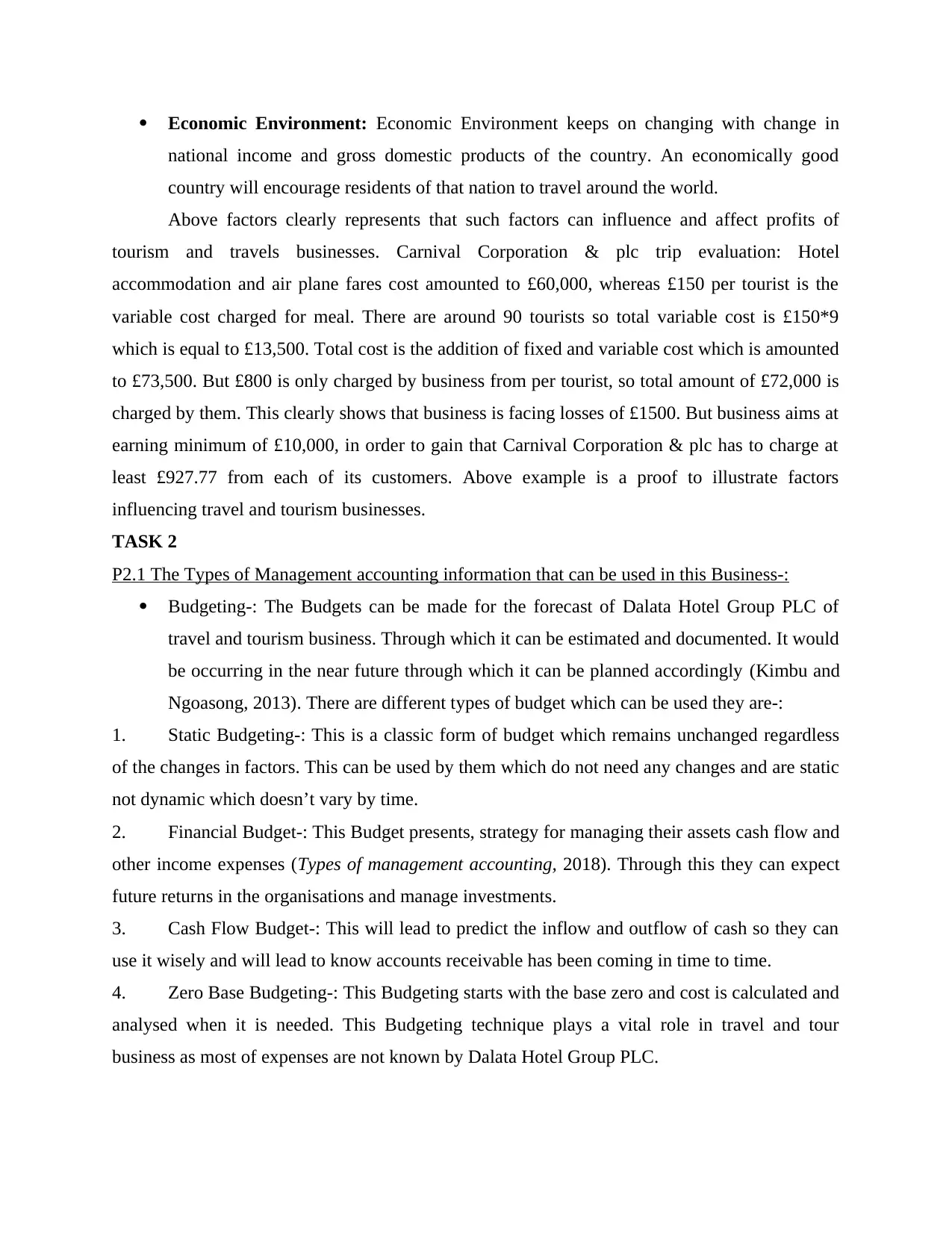
Economic Environment: Economic Environment keeps on changing with change in
national income and gross domestic products of the country. An economically good
country will encourage residents of that nation to travel around the world.
Above factors clearly represents that such factors can influence and affect profits of
tourism and travels businesses. Carnival Corporation & plc trip evaluation: Hotel
accommodation and air plane fares cost amounted to £60,000, whereas £150 per tourist is the
variable cost charged for meal. There are around 90 tourists so total variable cost is £150*9
which is equal to £13,500. Total cost is the addition of fixed and variable cost which is amounted
to £73,500. But £800 is only charged by business from per tourist, so total amount of £72,000 is
charged by them. This clearly shows that business is facing losses of £1500. But business aims at
earning minimum of £10,000, in order to gain that Carnival Corporation & plc has to charge at
least £927.77 from each of its customers. Above example is a proof to illustrate factors
influencing travel and tourism businesses.
TASK 2
P2.1 The Types of Management accounting information that can be used in this Business-:
Budgeting-: The Budgets can be made for the forecast of Dalata Hotel Group PLC of
travel and tourism business. Through which it can be estimated and documented. It would
be occurring in the near future through which it can be planned accordingly (Kimbu and
Ngoasong, 2013). There are different types of budget which can be used they are-:
1. Static Budgeting-: This is a classic form of budget which remains unchanged regardless
of the changes in factors. This can be used by them which do not need any changes and are static
not dynamic which doesn’t vary by time.
2. Financial Budget-: This Budget presents, strategy for managing their assets cash flow and
other income expenses (Types of management accounting, 2018). Through this they can expect
future returns in the organisations and manage investments.
3. Cash Flow Budget-: This will lead to predict the inflow and outflow of cash so they can
use it wisely and will lead to know accounts receivable has been coming in time to time.
4. Zero Base Budgeting-: This Budgeting starts with the base zero and cost is calculated and
analysed when it is needed. This Budgeting technique plays a vital role in travel and tour
business as most of expenses are not known by Dalata Hotel Group PLC.
national income and gross domestic products of the country. An economically good
country will encourage residents of that nation to travel around the world.
Above factors clearly represents that such factors can influence and affect profits of
tourism and travels businesses. Carnival Corporation & plc trip evaluation: Hotel
accommodation and air plane fares cost amounted to £60,000, whereas £150 per tourist is the
variable cost charged for meal. There are around 90 tourists so total variable cost is £150*9
which is equal to £13,500. Total cost is the addition of fixed and variable cost which is amounted
to £73,500. But £800 is only charged by business from per tourist, so total amount of £72,000 is
charged by them. This clearly shows that business is facing losses of £1500. But business aims at
earning minimum of £10,000, in order to gain that Carnival Corporation & plc has to charge at
least £927.77 from each of its customers. Above example is a proof to illustrate factors
influencing travel and tourism businesses.
TASK 2
P2.1 The Types of Management accounting information that can be used in this Business-:
Budgeting-: The Budgets can be made for the forecast of Dalata Hotel Group PLC of
travel and tourism business. Through which it can be estimated and documented. It would
be occurring in the near future through which it can be planned accordingly (Kimbu and
Ngoasong, 2013). There are different types of budget which can be used they are-:
1. Static Budgeting-: This is a classic form of budget which remains unchanged regardless
of the changes in factors. This can be used by them which do not need any changes and are static
not dynamic which doesn’t vary by time.
2. Financial Budget-: This Budget presents, strategy for managing their assets cash flow and
other income expenses (Types of management accounting, 2018). Through this they can expect
future returns in the organisations and manage investments.
3. Cash Flow Budget-: This will lead to predict the inflow and outflow of cash so they can
use it wisely and will lead to know accounts receivable has been coming in time to time.
4. Zero Base Budgeting-: This Budgeting starts with the base zero and cost is calculated and
analysed when it is needed. This Budgeting technique plays a vital role in travel and tour
business as most of expenses are not known by Dalata Hotel Group PLC.
⊘ This is a preview!⊘
Do you want full access?
Subscribe today to unlock all pages.

Trusted by 1+ million students worldwide
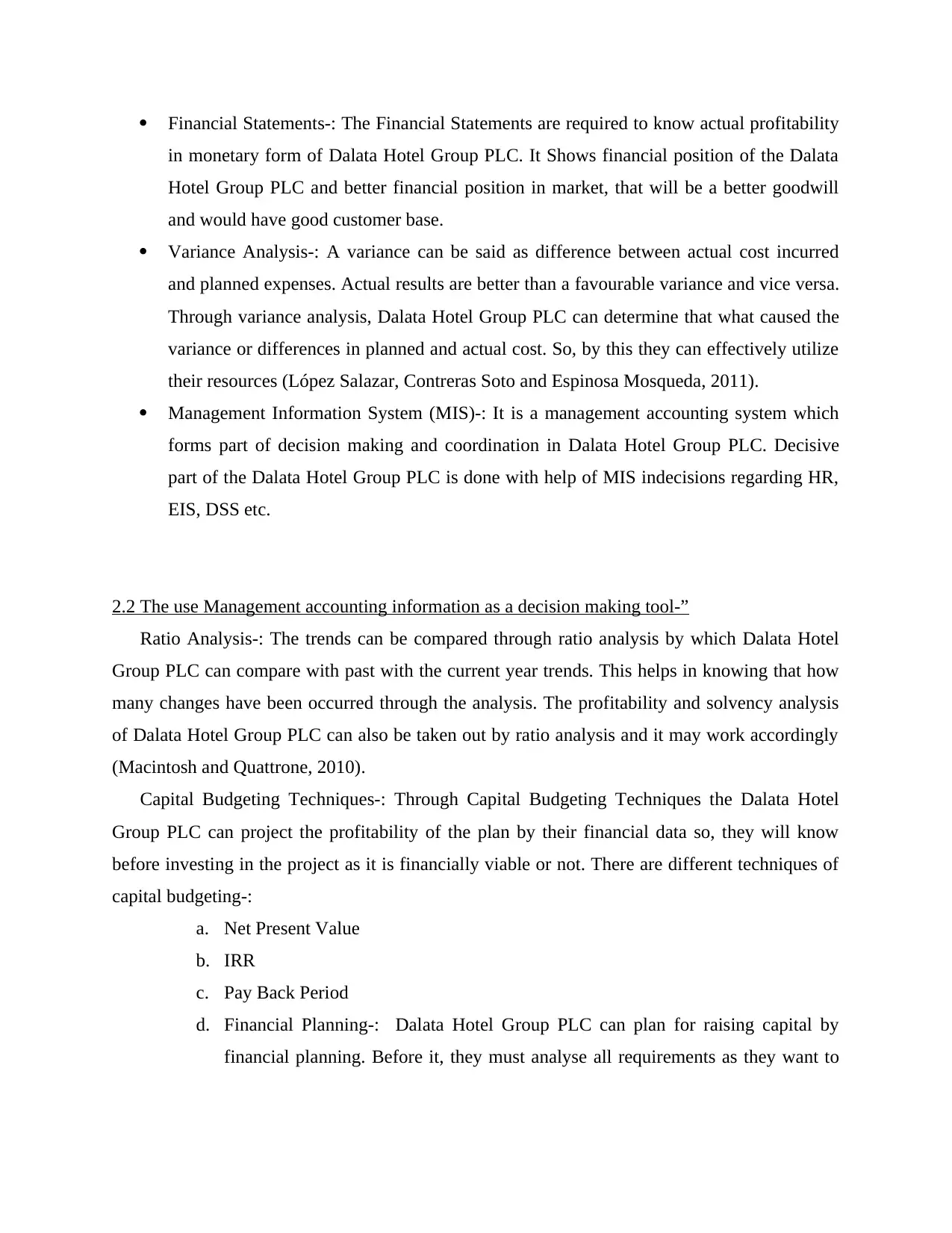
Financial Statements-: The Financial Statements are required to know actual profitability
in monetary form of Dalata Hotel Group PLC. It Shows financial position of the Dalata
Hotel Group PLC and better financial position in market, that will be a better goodwill
and would have good customer base.
Variance Analysis-: A variance can be said as difference between actual cost incurred
and planned expenses. Actual results are better than a favourable variance and vice versa.
Through variance analysis, Dalata Hotel Group PLC can determine that what caused the
variance or differences in planned and actual cost. So, by this they can effectively utilize
their resources (López Salazar, Contreras Soto and Espinosa Mosqueda, 2011).
Management Information System (MIS)-: It is a management accounting system which
forms part of decision making and coordination in Dalata Hotel Group PLC. Decisive
part of the Dalata Hotel Group PLC is done with help of MIS indecisions regarding HR,
EIS, DSS etc.
2.2 The use Management accounting information as a decision making tool-”
Ratio Analysis-: The trends can be compared through ratio analysis by which Dalata Hotel
Group PLC can compare with past with the current year trends. This helps in knowing that how
many changes have been occurred through the analysis. The profitability and solvency analysis
of Dalata Hotel Group PLC can also be taken out by ratio analysis and it may work accordingly
(Macintosh and Quattrone, 2010).
Capital Budgeting Techniques-: Through Capital Budgeting Techniques the Dalata Hotel
Group PLC can project the profitability of the plan by their financial data so, they will know
before investing in the project as it is financially viable or not. There are different techniques of
capital budgeting-:
a. Net Present Value
b. IRR
c. Pay Back Period
d. Financial Planning-: Dalata Hotel Group PLC can plan for raising capital by
financial planning. Before it, they must analyse all requirements as they want to
in monetary form of Dalata Hotel Group PLC. It Shows financial position of the Dalata
Hotel Group PLC and better financial position in market, that will be a better goodwill
and would have good customer base.
Variance Analysis-: A variance can be said as difference between actual cost incurred
and planned expenses. Actual results are better than a favourable variance and vice versa.
Through variance analysis, Dalata Hotel Group PLC can determine that what caused the
variance or differences in planned and actual cost. So, by this they can effectively utilize
their resources (López Salazar, Contreras Soto and Espinosa Mosqueda, 2011).
Management Information System (MIS)-: It is a management accounting system which
forms part of decision making and coordination in Dalata Hotel Group PLC. Decisive
part of the Dalata Hotel Group PLC is done with help of MIS indecisions regarding HR,
EIS, DSS etc.
2.2 The use Management accounting information as a decision making tool-”
Ratio Analysis-: The trends can be compared through ratio analysis by which Dalata Hotel
Group PLC can compare with past with the current year trends. This helps in knowing that how
many changes have been occurred through the analysis. The profitability and solvency analysis
of Dalata Hotel Group PLC can also be taken out by ratio analysis and it may work accordingly
(Macintosh and Quattrone, 2010).
Capital Budgeting Techniques-: Through Capital Budgeting Techniques the Dalata Hotel
Group PLC can project the profitability of the plan by their financial data so, they will know
before investing in the project as it is financially viable or not. There are different techniques of
capital budgeting-:
a. Net Present Value
b. IRR
c. Pay Back Period
d. Financial Planning-: Dalata Hotel Group PLC can plan for raising capital by
financial planning. Before it, they must analyse all requirements as they want to
Paraphrase This Document
Need a fresh take? Get an instant paraphrase of this document with our AI Paraphraser
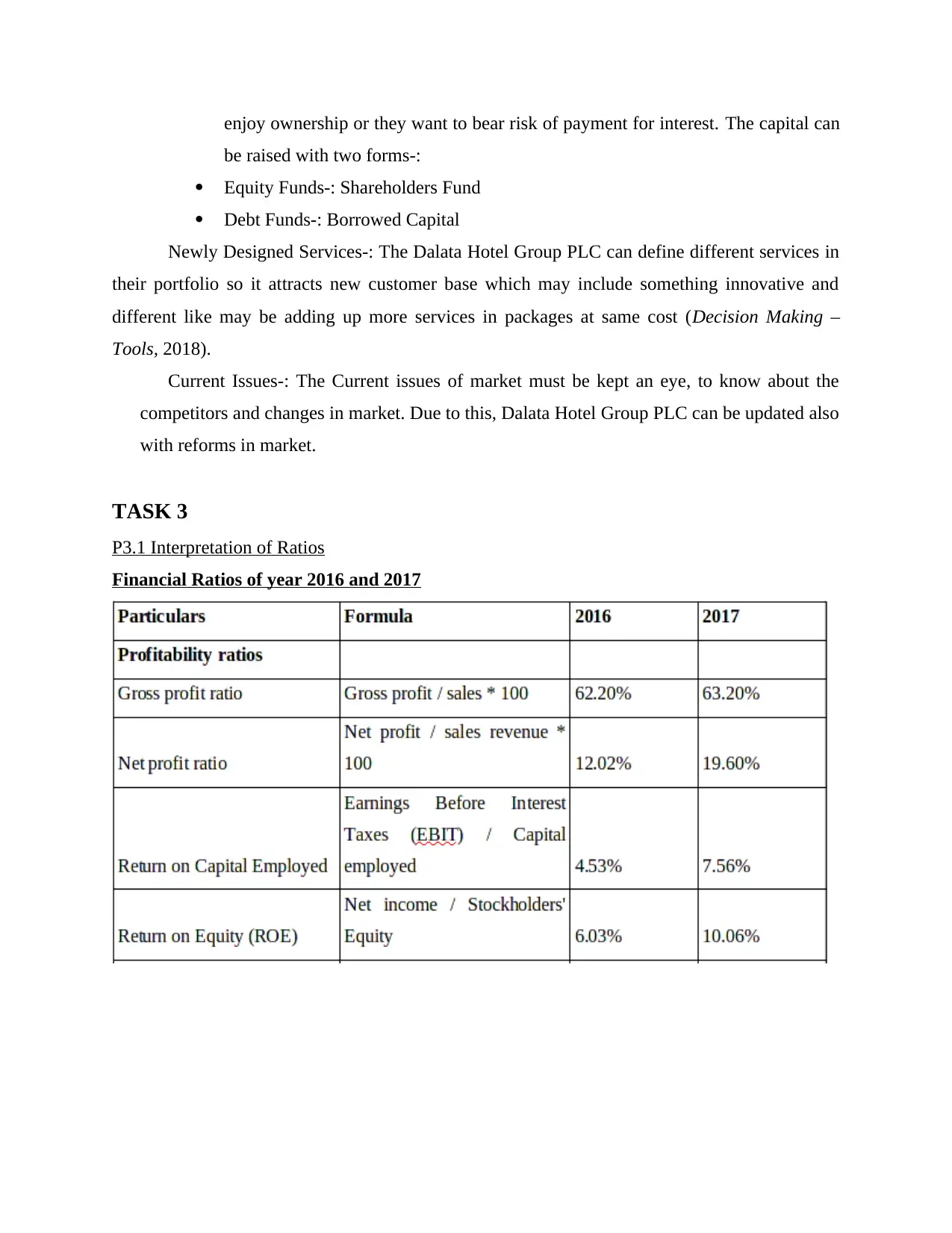
enjoy ownership or they want to bear risk of payment for interest. The capital can
be raised with two forms-:
Equity Funds-: Shareholders Fund
Debt Funds-: Borrowed Capital
Newly Designed Services-: The Dalata Hotel Group PLC can define different services in
their portfolio so it attracts new customer base which may include something innovative and
different like may be adding up more services in packages at same cost (Decision Making –
Tools, 2018).
Current Issues-: The Current issues of market must be kept an eye, to know about the
competitors and changes in market. Due to this, Dalata Hotel Group PLC can be updated also
with reforms in market.
TASK 3
P3.1 Interpretation of Ratios
Financial Ratios of year 2016 and 2017
be raised with two forms-:
Equity Funds-: Shareholders Fund
Debt Funds-: Borrowed Capital
Newly Designed Services-: The Dalata Hotel Group PLC can define different services in
their portfolio so it attracts new customer base which may include something innovative and
different like may be adding up more services in packages at same cost (Decision Making –
Tools, 2018).
Current Issues-: The Current issues of market must be kept an eye, to know about the
competitors and changes in market. Due to this, Dalata Hotel Group PLC can be updated also
with reforms in market.
TASK 3
P3.1 Interpretation of Ratios
Financial Ratios of year 2016 and 2017
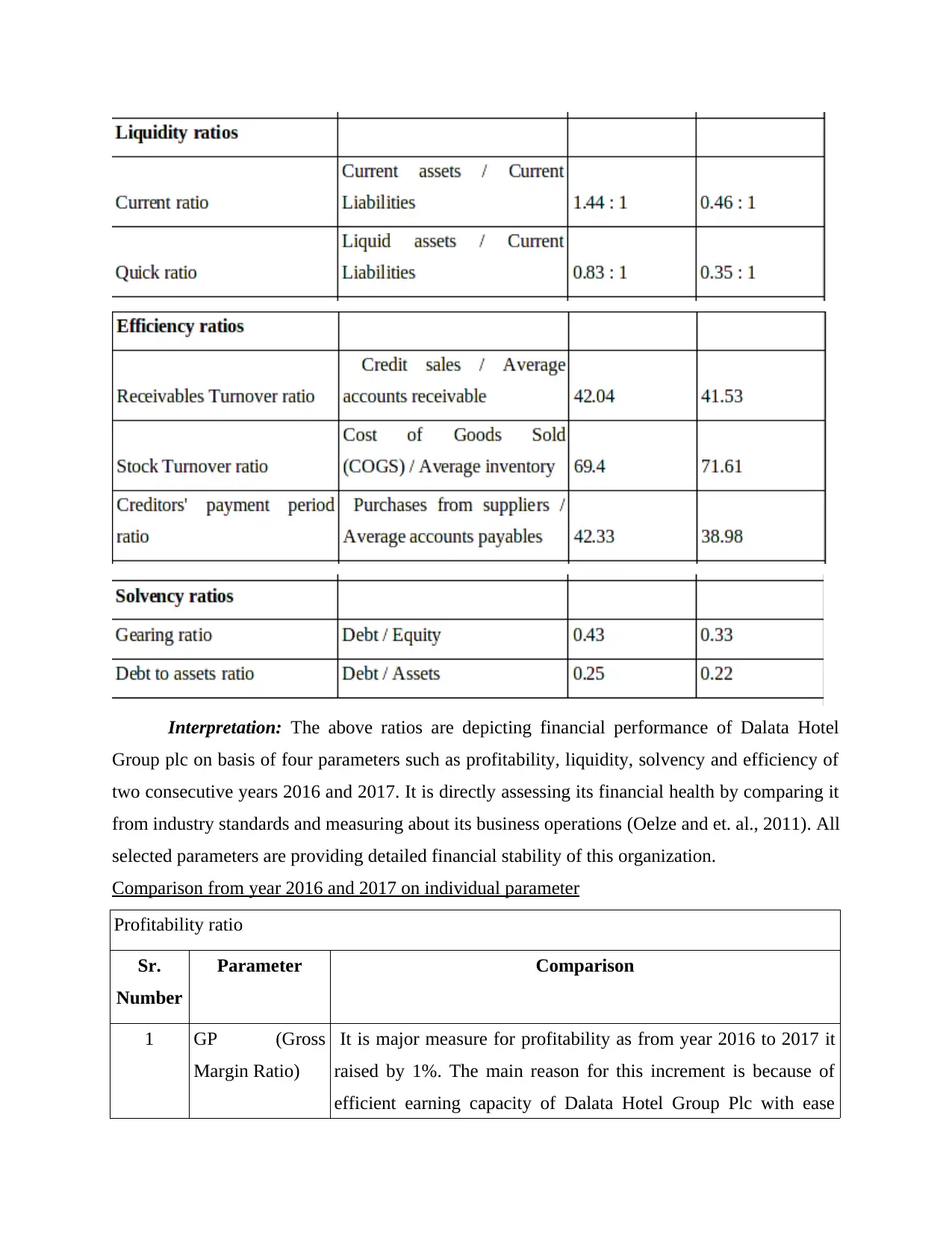
Interpretation: The above ratios are depicting financial performance of Dalata Hotel
Group plc on basis of four parameters such as profitability, liquidity, solvency and efficiency of
two consecutive years 2016 and 2017. It is directly assessing its financial health by comparing it
from industry standards and measuring about its business operations (Oelze and et. al., 2011). All
selected parameters are providing detailed financial stability of this organization.
Comparison from year 2016 and 2017 on individual parameter
Profitability ratio
Sr.
Number
Parameter Comparison
1 GP (Gross
Margin Ratio)
It is major measure for profitability as from year 2016 to 2017 it
raised by 1%. The main reason for this increment is because of
efficient earning capacity of Dalata Hotel Group Plc with ease
Group plc on basis of four parameters such as profitability, liquidity, solvency and efficiency of
two consecutive years 2016 and 2017. It is directly assessing its financial health by comparing it
from industry standards and measuring about its business operations (Oelze and et. al., 2011). All
selected parameters are providing detailed financial stability of this organization.
Comparison from year 2016 and 2017 on individual parameter
Profitability ratio
Sr.
Number
Parameter Comparison
1 GP (Gross
Margin Ratio)
It is major measure for profitability as from year 2016 to 2017 it
raised by 1%. The main reason for this increment is because of
efficient earning capacity of Dalata Hotel Group Plc with ease
⊘ This is a preview!⊘
Do you want full access?
Subscribe today to unlock all pages.

Trusted by 1+ million students worldwide
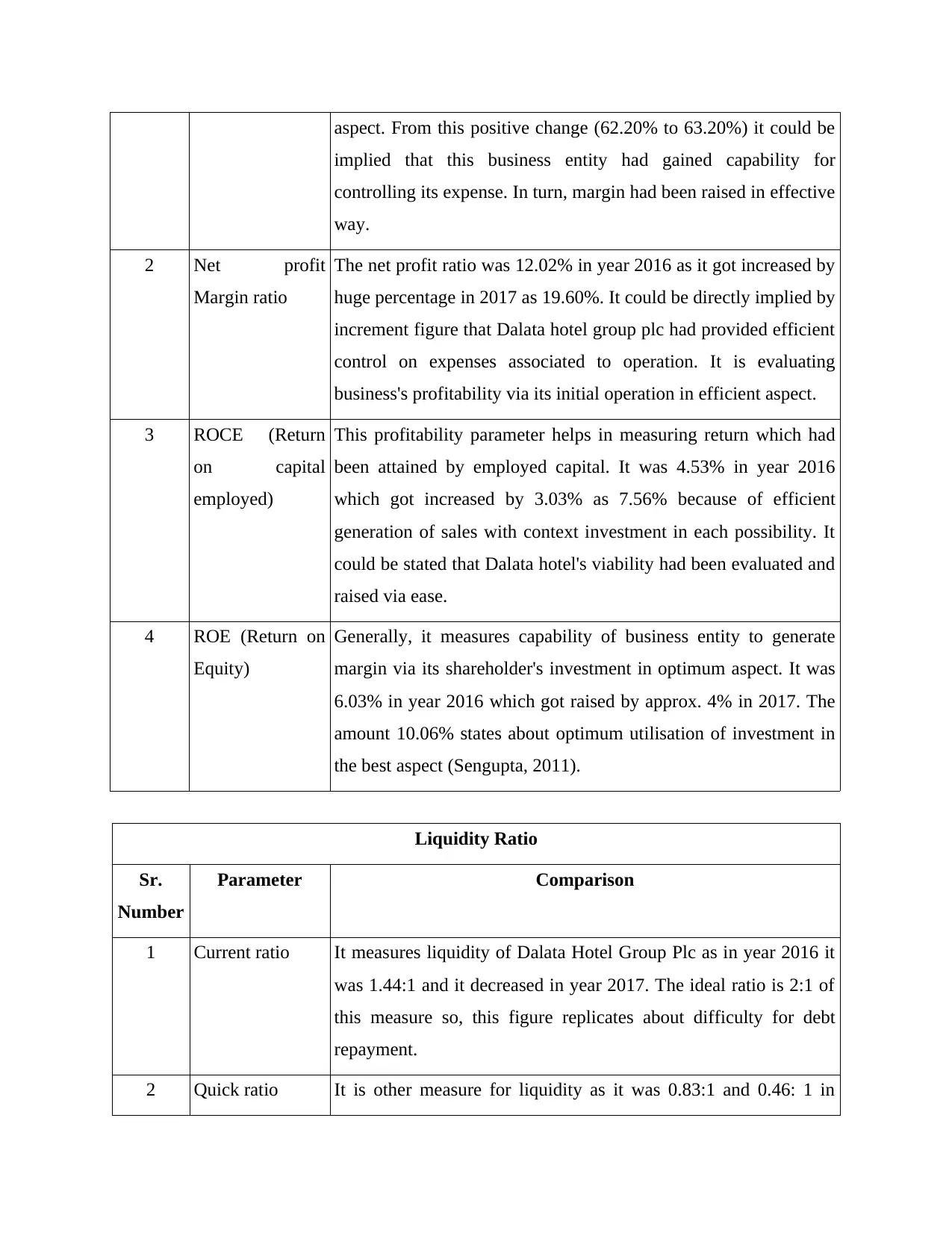
aspect. From this positive change (62.20% to 63.20%) it could be
implied that this business entity had gained capability for
controlling its expense. In turn, margin had been raised in effective
way.
2 Net profit
Margin ratio
The net profit ratio was 12.02% in year 2016 as it got increased by
huge percentage in 2017 as 19.60%. It could be directly implied by
increment figure that Dalata hotel group plc had provided efficient
control on expenses associated to operation. It is evaluating
business's profitability via its initial operation in efficient aspect.
3 ROCE (Return
on capital
employed)
This profitability parameter helps in measuring return which had
been attained by employed capital. It was 4.53% in year 2016
which got increased by 3.03% as 7.56% because of efficient
generation of sales with context investment in each possibility. It
could be stated that Dalata hotel's viability had been evaluated and
raised via ease.
4 ROE (Return on
Equity)
Generally, it measures capability of business entity to generate
margin via its shareholder's investment in optimum aspect. It was
6.03% in year 2016 which got raised by approx. 4% in 2017. The
amount 10.06% states about optimum utilisation of investment in
the best aspect (Sengupta, 2011).
Liquidity Ratio
Sr.
Number
Parameter Comparison
1 Current ratio It measures liquidity of Dalata Hotel Group Plc as in year 2016 it
was 1.44:1 and it decreased in year 2017. The ideal ratio is 2:1 of
this measure so, this figure replicates about difficulty for debt
repayment.
2 Quick ratio It is other measure for liquidity as it was 0.83:1 and 0.46: 1 in
implied that this business entity had gained capability for
controlling its expense. In turn, margin had been raised in effective
way.
2 Net profit
Margin ratio
The net profit ratio was 12.02% in year 2016 as it got increased by
huge percentage in 2017 as 19.60%. It could be directly implied by
increment figure that Dalata hotel group plc had provided efficient
control on expenses associated to operation. It is evaluating
business's profitability via its initial operation in efficient aspect.
3 ROCE (Return
on capital
employed)
This profitability parameter helps in measuring return which had
been attained by employed capital. It was 4.53% in year 2016
which got increased by 3.03% as 7.56% because of efficient
generation of sales with context investment in each possibility. It
could be stated that Dalata hotel's viability had been evaluated and
raised via ease.
4 ROE (Return on
Equity)
Generally, it measures capability of business entity to generate
margin via its shareholder's investment in optimum aspect. It was
6.03% in year 2016 which got raised by approx. 4% in 2017. The
amount 10.06% states about optimum utilisation of investment in
the best aspect (Sengupta, 2011).
Liquidity Ratio
Sr.
Number
Parameter Comparison
1 Current ratio It measures liquidity of Dalata Hotel Group Plc as in year 2016 it
was 1.44:1 and it decreased in year 2017. The ideal ratio is 2:1 of
this measure so, this figure replicates about difficulty for debt
repayment.
2 Quick ratio It is other measure for liquidity as it was 0.83:1 and 0.46: 1 in
Paraphrase This Document
Need a fresh take? Get an instant paraphrase of this document with our AI Paraphraser
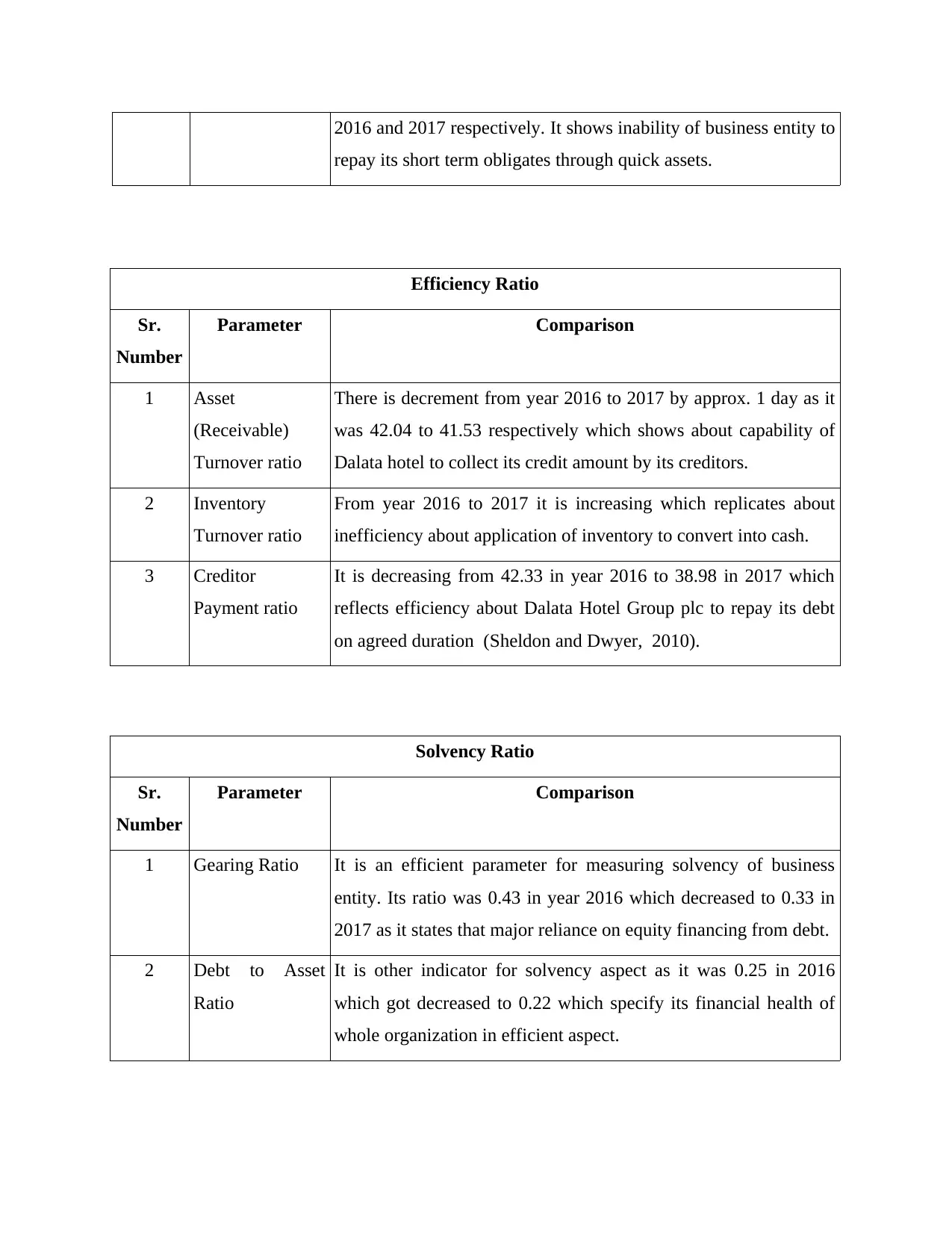
2016 and 2017 respectively. It shows inability of business entity to
repay its short term obligates through quick assets.
Efficiency Ratio
Sr.
Number
Parameter Comparison
1 Asset
(Receivable)
Turnover ratio
There is decrement from year 2016 to 2017 by approx. 1 day as it
was 42.04 to 41.53 respectively which shows about capability of
Dalata hotel to collect its credit amount by its creditors.
2 Inventory
Turnover ratio
From year 2016 to 2017 it is increasing which replicates about
inefficiency about application of inventory to convert into cash.
3 Creditor
Payment ratio
It is decreasing from 42.33 in year 2016 to 38.98 in 2017 which
reflects efficiency about Dalata Hotel Group plc to repay its debt
on agreed duration (Sheldon and Dwyer, 2010).
Solvency Ratio
Sr.
Number
Parameter Comparison
1 Gearing Ratio It is an efficient parameter for measuring solvency of business
entity. Its ratio was 0.43 in year 2016 which decreased to 0.33 in
2017 as it states that major reliance on equity financing from debt.
2 Debt to Asset
Ratio
It is other indicator for solvency aspect as it was 0.25 in 2016
which got decreased to 0.22 which specify its financial health of
whole organization in efficient aspect.
repay its short term obligates through quick assets.
Efficiency Ratio
Sr.
Number
Parameter Comparison
1 Asset
(Receivable)
Turnover ratio
There is decrement from year 2016 to 2017 by approx. 1 day as it
was 42.04 to 41.53 respectively which shows about capability of
Dalata hotel to collect its credit amount by its creditors.
2 Inventory
Turnover ratio
From year 2016 to 2017 it is increasing which replicates about
inefficiency about application of inventory to convert into cash.
3 Creditor
Payment ratio
It is decreasing from 42.33 in year 2016 to 38.98 in 2017 which
reflects efficiency about Dalata Hotel Group plc to repay its debt
on agreed duration (Sheldon and Dwyer, 2010).
Solvency Ratio
Sr.
Number
Parameter Comparison
1 Gearing Ratio It is an efficient parameter for measuring solvency of business
entity. Its ratio was 0.43 in year 2016 which decreased to 0.33 in
2017 as it states that major reliance on equity financing from debt.
2 Debt to Asset
Ratio
It is other indicator for solvency aspect as it was 0.25 in 2016
which got decreased to 0.22 which specify its financial health of
whole organization in efficient aspect.
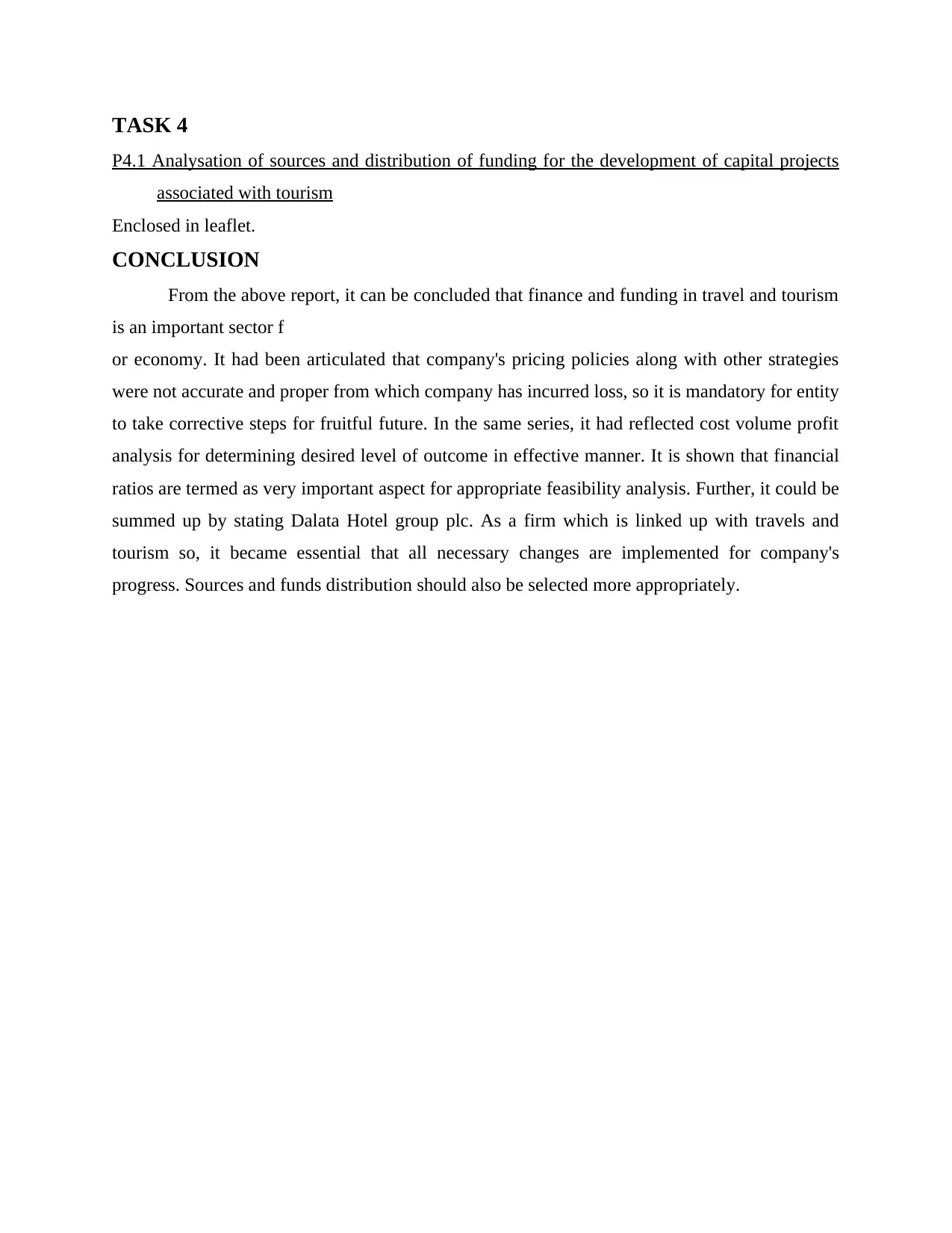
TASK 4
P4.1 Analysation of sources and distribution of funding for the development of capital projects
associated with tourism
Enclosed in leaflet.
CONCLUSION
From the above report, it can be concluded that finance and funding in travel and tourism
is an important sector f
or economy. It had been articulated that company's pricing policies along with other strategies
were not accurate and proper from which company has incurred loss, so it is mandatory for entity
to take corrective steps for fruitful future. In the same series, it had reflected cost volume profit
analysis for determining desired level of outcome in effective manner. It is shown that financial
ratios are termed as very important aspect for appropriate feasibility analysis. Further, it could be
summed up by stating Dalata Hotel group plc. As a firm which is linked up with travels and
tourism so, it became essential that all necessary changes are implemented for company's
progress. Sources and funds distribution should also be selected more appropriately.
P4.1 Analysation of sources and distribution of funding for the development of capital projects
associated with tourism
Enclosed in leaflet.
CONCLUSION
From the above report, it can be concluded that finance and funding in travel and tourism
is an important sector f
or economy. It had been articulated that company's pricing policies along with other strategies
were not accurate and proper from which company has incurred loss, so it is mandatory for entity
to take corrective steps for fruitful future. In the same series, it had reflected cost volume profit
analysis for determining desired level of outcome in effective manner. It is shown that financial
ratios are termed as very important aspect for appropriate feasibility analysis. Further, it could be
summed up by stating Dalata Hotel group plc. As a firm which is linked up with travels and
tourism so, it became essential that all necessary changes are implemented for company's
progress. Sources and funds distribution should also be selected more appropriately.
⊘ This is a preview!⊘
Do you want full access?
Subscribe today to unlock all pages.

Trusted by 1+ million students worldwide
1 out of 15
Related Documents
Your All-in-One AI-Powered Toolkit for Academic Success.
+13062052269
info@desklib.com
Available 24*7 on WhatsApp / Email
![[object Object]](/_next/static/media/star-bottom.7253800d.svg)
Unlock your academic potential
Copyright © 2020–2025 A2Z Services. All Rights Reserved. Developed and managed by ZUCOL.





